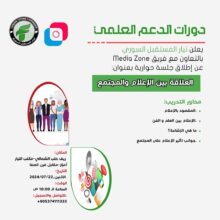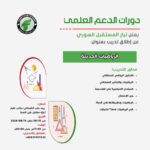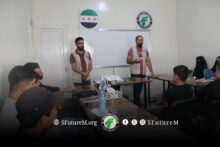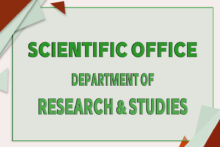On the Animal Sector in Syria: Reality and Challenges

Introduction:
World Animal Day is celebrated on October 4th each year. The aim of World Animal Day is to raise awareness about the importance of animals and their rights, encourage people to protect them, and work to improve their living conditions. It serves as an opportunity to focus on the challenges facing both wild and domestic animals and to work together to protect endangered species and enhance the welfare of all animals.
The aims of dedicating this day are:
- To raise awareness about the diversity of animal life and its importance to the ecosystem.
- To protect endangered species through conservation efforts.
- To improve the welfare of animals, whether wild or domestic.
- To promote international cooperation between governments and organizations for the protection of animals.
The Reality of the Animal Sector in Syria Before the 2011 Revolution:
Before the outbreak of the Syrian revolution, the animal sector was an important part of the Syrian economy and significantly contributed to ensuring food security for the population. This sector was characterized by the following features:
- Diversity of Production: Animal production was diverse and included many species such as cattle, sheep, goats, camels, and poultry.
- Importance of Livestock: Livestock was an important source of income for many Syrian families, especially in rural areas.
- Reliance on Natural Pastures: A large part of animal husbandry relied on the natural pastures available in the Syrian steppe.
- Challenges Present: The animal sector faced some challenges, such as:
- A. Lack of modern technology in production.
- B. Spread of animal diseases.
- C. Insufficient investments in the development of the sector.
The Most Prominent Animal Sectors Before the Revolution:
- Sheep and Goat Farming: This was the most widespread type of animal husbandry, especially in arid and semi-arid regions.
- Cattle Farming: This was concentrated in irrigated areas, and its products, including milk and meat, met part of the local needs.
- Poultry Farming: This sector experienced significant growth before the revolution, particularly in egg production.
Key Reasons for the Importance of the Animal Sector in Syria:
- Food Security: The animal sector provided a substantial portion of animal protein for local consumption.
- National Economy: It contributed to the gross domestic product and provided job opportunities for many families.
- Exports: Some animal products were exported to neighboring countries.
This is an overview of the state of the animal sector in Syria before the revolution.
The State of the Animal Sector in Syria After the Revolution:
The animal sector in Syria experienced severe deterioration following the outbreak of the Syrian revolution, due to several reasons, including:
- War and Destruction: The war led to the destruction of agricultural infrastructure, including farms, animal pens, and livestock shelters, resulting in significant losses in livestock.
- Feed Shortages: A lack of water and fodder crops caused feed prices to rise dramatically, making it difficult for many breeders to provide food for their animals.
- Disease Outbreaks: The absence of veterinary care and widespread malnutrition among animals contributed to the spread of numerous animal diseases.
- Displacement and Migration: Internal and external displacement left many farms and livestock unattended, exacerbating the scale of losses.
- Theft and Looting: Many farms and herds were subjected to theft and looting, leading to significant losses in livestock.
The Most Prominent Challenges Facing the Animal Sector Currently:
- The animal sector is suffering from a lack of necessary funding for its rehabilitation and development.
- There is a shortage of qualified personnel in the fields of animal production and veterinary care.
- Climate change negatively impacts animal production, especially in arid and semi-arid regions.
- The smuggling of livestock to neighboring countries poses a significant challenge to the animal sector.
Specific Challenges in Northern Syria Include:
- Displacement and Migration: This necessitates finding permanent solutions for the issue of displaced and relocated individuals and providing support for their return to their original areas.
- Landmines: The need to remove landmines from agricultural lands to ensure the safety of farmers.
- Climate Change: The necessity to adapt to climate changes and develop sustainable agricultural practices.
The Negative Effects of the Deterioration of the Animal Sector:
- Meat and dairy production has significantly decreased, leading to rising prices.
- The shortage of animal products has exacerbated food insecurity, especially in war-affected areas.
- The decline of the animal sector has resulted in the loss of many job opportunities in rural areas.
All of this has made the animal sector in urgent need of significant efforts. Although there are substantial challenges, various efforts are being made to revive the animal sector in Syria through:
- Providing financial and technical support to farmers by supplying seeds, fodder, and loans.
- Training farmers in modern production methods to improve production efficiency.
- Combating animal diseases by vaccinating livestock and providing veterinary care.
- Rehabilitating agricultural infrastructure by rebuilding barns and farms.
The animal sector in Syria is suffering from significant deterioration due to war and conflict. Despite the efforts made to revive it, the road ahead remains long and arduous. Reviving this vital sector requires substantial investments and collaborative efforts from various Syrian authorities, international organizations, and civil society.
Recommendations to Overcome the Challenges of Reforming the Animal Sector in Syria:
After reviewing the unfortunate reality of the animal sector in Syria, particularly in its northern regions, we find that there are many challenges facing this sector that require comprehensive and integrated solutions. Here are some recommendations that could contribute to overcoming these challenges:
Challenges and Revitalization of this Vital Sector:
- At the General Level:
- A. Ending the Conflict: There is no doubt that ending the military conflict is a fundamental condition for the reconstruction of Syria, including the livestock sector.
- B. Stability of Security Conditions: Providing a safe and stable environment for farmers and herders so they can freely carry out their work.
- C. Government Support: The four Syrian governments must play a pivotal role in supporting the livestock sector by providing the necessary infrastructure and offering financial and technical assistance to farmers.
- D. International Cooperation: The international community must provide the necessary support for Syria to rebuild the livestock sector through financial and technical aid, as well as the exchange of expertise.
- E. Investment in Research and Development: Investment should be made in research and development to create disease-resistant livestock breeds and develop new techniques in animal production.
- At the Livestock Sector Level:
- A. Rehabilitation of Infrastructure: Rebuild destroyed barns, farms, and animal quarantine facilities.
- B. Securing Animal Feed: Work on securing the necessary animal feed, whether through local production or import.
- C. Disease Control: Develop programs to combat animal diseases and provide necessary vaccines and treatments.
- D. Training for Farmers: Offer training to farmers on the latest methods in animal production and veterinary care.
- E. Establishing Organized Markets: Create organized markets for animal products and provide means for their marketing.
- F. Encouraging Investment: Promote investment in the livestock sector and simplify bureaucratic procedures.
- G. Implementing Quality Standards: Apply quality standards to animal products to ensure their safety.
- At the Local Community Level:
- A. Empowering Farmers: Enable farmers to make decisions regarding their production and provide support to increase their productivity.
- B. Encouraging Agricultural Cooperatives: Promote the formation of agricultural cooperatives to share resources and technology.
- C. Raising Awareness: Raise awareness of the importance of the livestock sector and its role in achieving food security.
Conclusion:
Reviving the livestock sector in Syria requires joint efforts from the four Syrian governments (the Syrian regime, the interim government, the Rescue Government, and the Autonomous Administration), as well as from the international community, non-governmental organizations, and the farmers themselves. By implementing these recommendations, Syria can reclaim its status as a producer of livestock wealth and achieve food security for its people. This goal has been recognized as one of the primary objectives by the Economic Office of the Syrian Future Movement (SFM), as emphasized in its foundational documents within the organizational office. One of the documents from the Syrian Future Movement (SFM) is titled “The Syrian Future Movement (SFM) and Animal Rights,” which has been highlighted by the media office of the Syrian Future Movement (SFM), which issued a series of visions we are working towards. Among these visions is the Syrian future dream titled “The Thirteenth Dream: (Compassion for Animals),” which we call for continued support and follow-up from our incubators, our people, and the authorities on the ground in Syria.
Economic Office
Economic Office Team
Scientific Office
Research and Studies Department
Articles
Syrian Future Movement (SFM)






